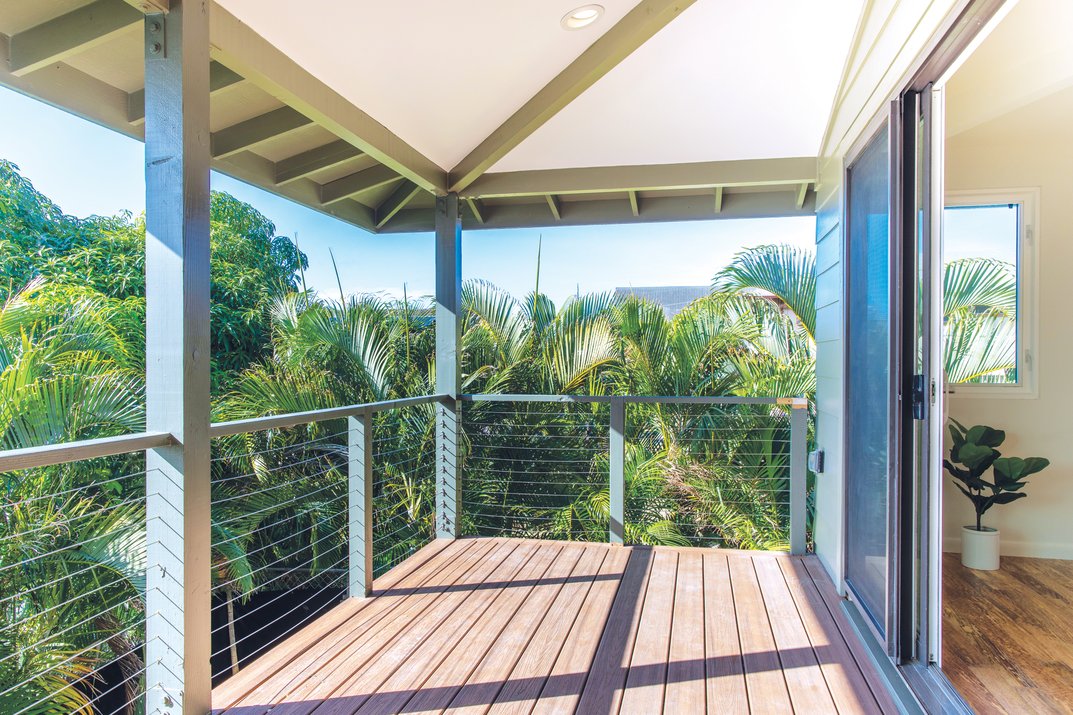
Hawaii’s beautiful islands are known around the world for their glorious weather.
However, as locals know very well, Oahu has its own “climate zones” — areas whose weather patterns and conditions are subtly different from the sunny stereotype.
“Some properties get a lot of rain, wind or salt spray, which must be considered,” says Malia Yee, senior designer for Graham Builders. “And properties with no particular climate challenges might be located on a busy corner or near a bus stop. Every home should be designed for its own unique surroundings.”
Damp properties
Before any project begins, Yee and her team thoroughly study each site, observing conditions and thinking about how to maximize the comfort, privacy and beauty of each home.
On properties in wetter surroundings, houses are sited — positioned on the lot — so that drainage flows away from them. Yee recommends post and pier foundations for such homes.
“They’re less susceptible to flooding, and offer storage space under the house and easy access to plumbing,” she explains. “Additionally, depending on soils and topography, costs can be lower than for a slab foundation.”
Typical design features for wetter environments include connected garages, and covered walkways and entryways. Proper construction techniques are employed for building wrap and siding finishes. Trex decking is often used, because it doesn’t need painting and won’t rot.
“We always consider which direction the predominant wind and rain come from,” Yee adds. “On that side of the house, we plan for larger overhangs, higher or double-hung windows, and no entry doors. We recommend no carpeting in these homes, and outlets in closets for dehumidifiers.”
Beachfront
Living on or near the ocean is delightful, but extreme exposure to seaside elements, especially salt, can cause a great deal of wear and tear on structures over time. Residential elevations must follow Federal Emergency Management Agency requirements to protect the home from storm surges.
“We recommend impact-rated windows and walls, and concrete floors,” Yee says. “Also, ocean breezes can be less than pleasant when they are heavy and constant. Windows and doors should be thoughtfully oriented for homeowner comfort.”
Retaining walls
Because most of Graham Builders’ projects are designed and built for generations of families, the company takes no shortcuts. For example, the firm’s designers view retaining walls as a feature meant to hold back earth. These barriers never serve as the house walls of Graham Builders-built homes.
“Some builders do this, but the walls of your house should not hold back earth,” Yee explains. “In time, the pressure of the earth will break down the sheathing on the wall, which can result in problems with mold, mildew, termites and other pests.”
Corner lots
Corner lots can be challenging, but the Graham Builders team employs a variety of design techniques to help ensure privacy and sound reduction for homeowners.
The topography of a corner lot often informs the location of a home’s driveway and garage, and its overall design. House designs must allow for driver visibility around corners as well.
“The main thing is to avoid building a structure with a corner that thrusts out toward the intersection,” says Yee, who instead designs homes with an “inside” corner on these lots. “That opens the yard so you can cluster trees, adding privacy, while minimizing street noise. Remember, ‘curb appeal’ is a complementary combination of design and landscaping.”
Founded in 1990, Graham Builders remains the only contractor in Hawaii honored by the Better Business Bureau’s Torch Award for Business Ethics. Plan dream homes with Graham Builders’ free Building Your Home for Life seminar from 9 to 11 a.m. on Aug. 10 at Honolulu Country Club. Register at grahambuilders.com or call 808-593-2808.
GRAHAM BUILDERS
Contact
808-593-2808
Web
grahambuilders.com
See more articles from: Graham Builders